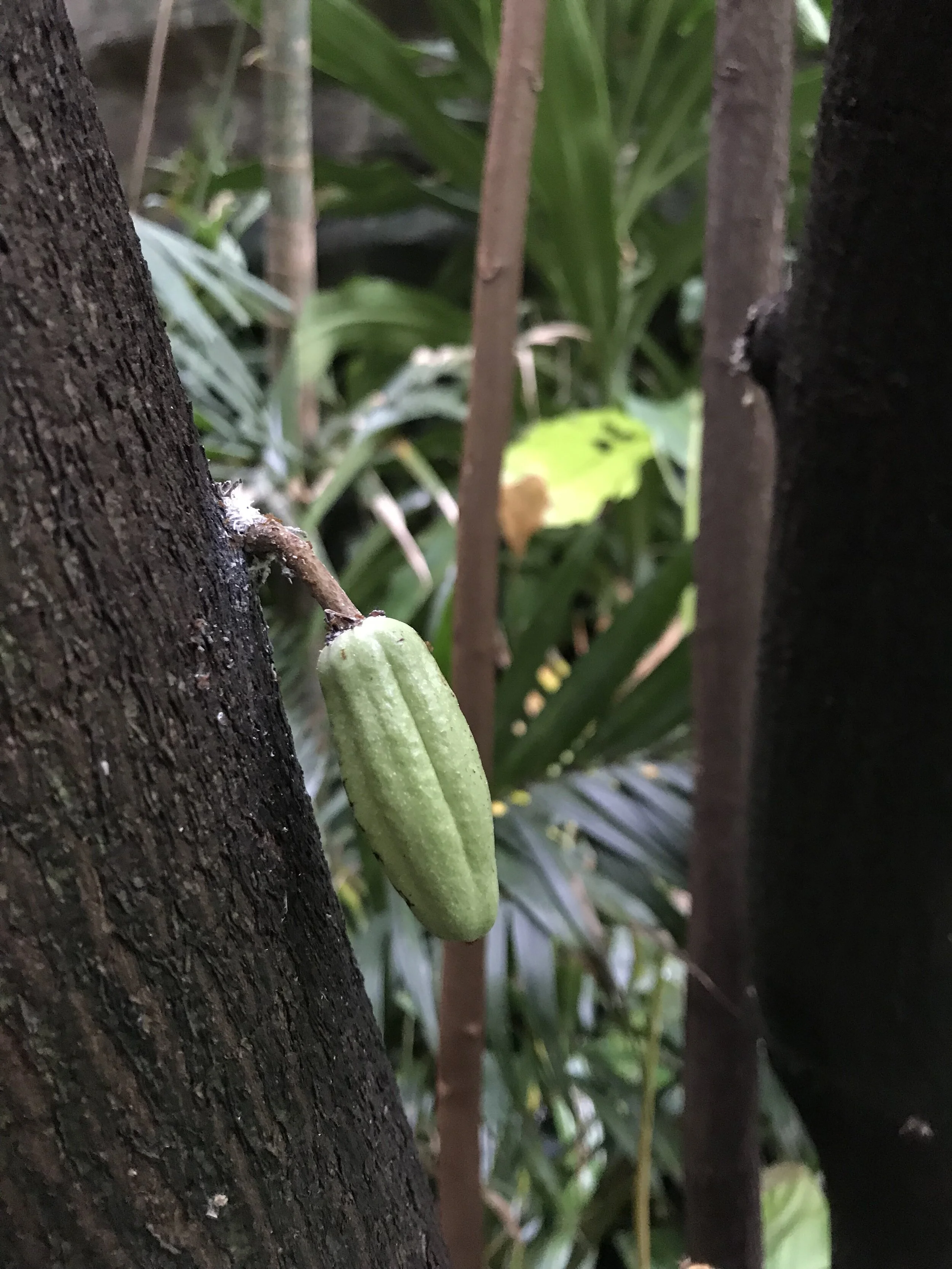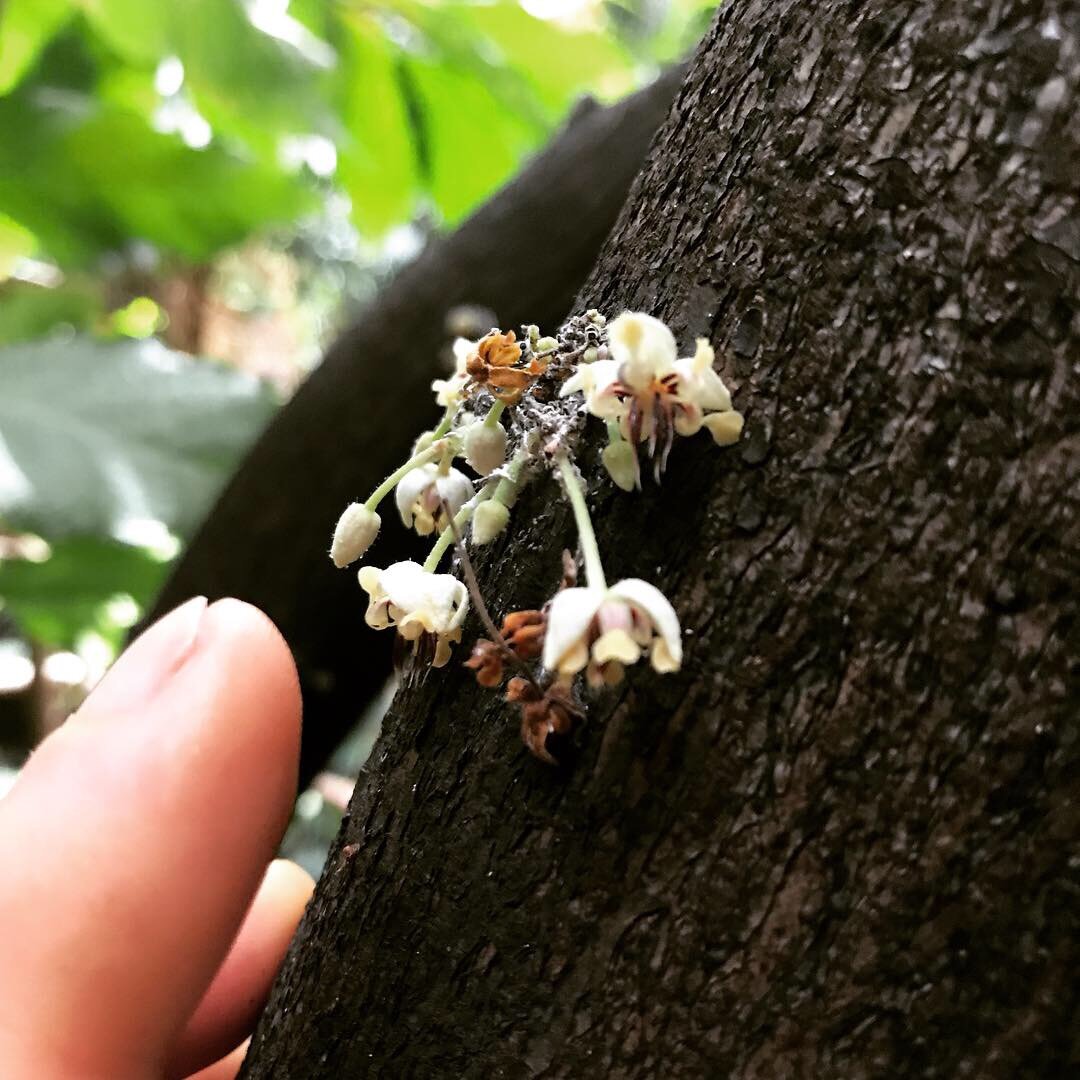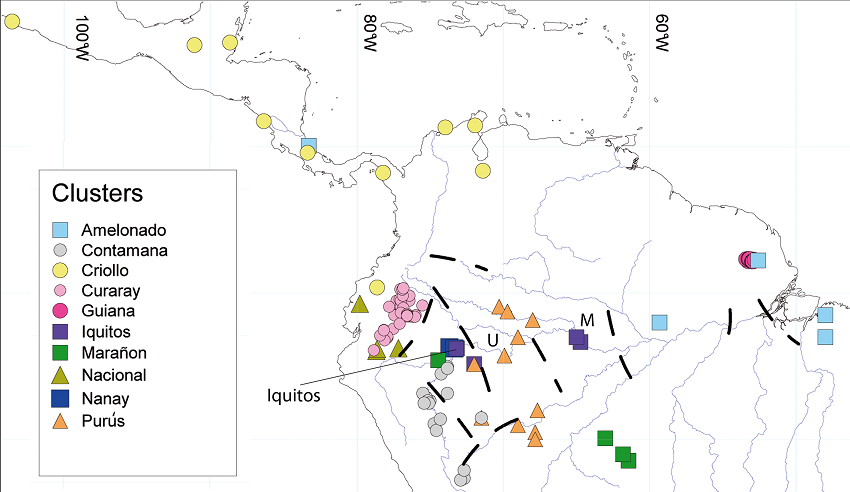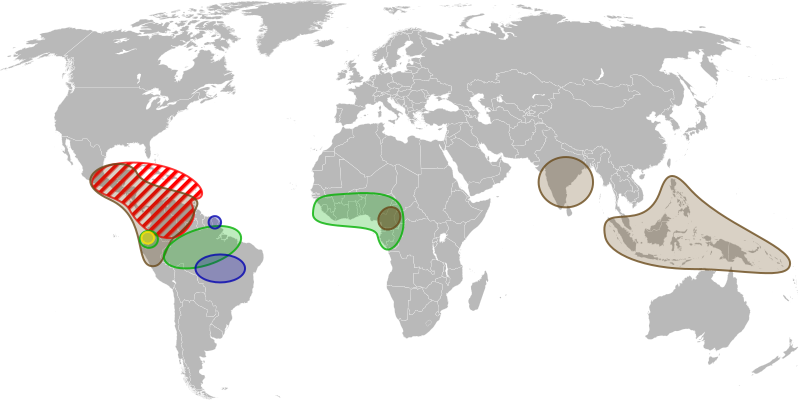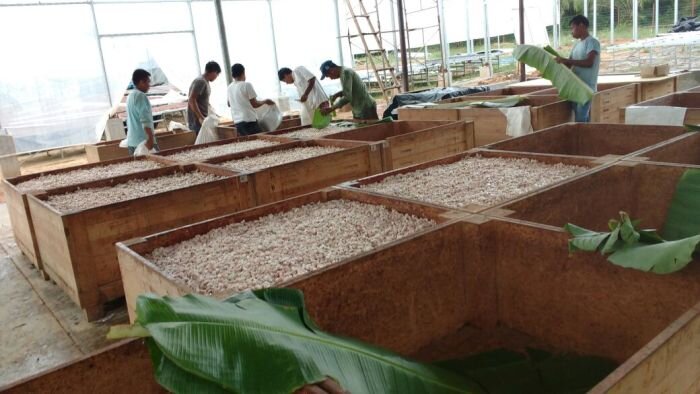The History Of Cacao Dispersal
Here is a brief overview of where cacao originated, and how it traveled across the globe to where it grows today.
Timeline
10 million years ago
The genus "Theobroma" exists
15 000 to 10 000 years BC
Theobroma cacao exists; humans inhabit South America
+ Part 1: A Fruity Beginning
When we think about chocolate, fruity is not usually a flavour that comes to mind. However, it's the fruit of the tree, Theobroma cacao, that first attracted humans to this plant. Chocolate is made from the seed of cacao, each segment surrounded by a fleshy sweet and tart fruit.
The genus "Theobroma" evolved in the hot and humid Northern Amazon region about 10 million years ago, before humans existed. Humans are believed to have entered South America around 15 000 to 10 000 years before present, which coincidentally is around the same time the species Theobroma cacao is believed to have evolved in the Northern Amazon. For this reason, it has been hypothesized that humans may have crossed different species of Theobroma and unintentionally created the species T. cacao.
From The Northern Amazon, cacao was then transported North into what is now Southern Mexico and Guatemala, via migrating humans and possibly through trade, and planted in regions along the way. At some point in history, the seed of the cacao became utilized to create a drink. Today we call that drink chocolate, but we don't know what the original name for it was. The earliest evidence we have of chocolate exists at the site of Santa Ana-La Florida in Southern Ecuador. Pottery meant to hold liquids were found to contain the chemicals theobroma and caffeine, dated to as early as 3500 BCE. These two alkaloids are found only in cacao seeds and not in any other botanicals in this region of the world.
As cacao migrated Northwards into the Isthmus of Panama to Southern Mexico, a variety of cacao was established, known as Circum-Caribbean or "Criollo" cacao, which was different from the varieties from which it originated. This cacao will later be coveted for its delicate aroma and dynamic flavour.
The exact path of cacao into Mesoamerica, where chocolate culture flourished, is not known. There has been a suggestion that the Circum-Caribbean cacao already existed in Central America before humans arrived. The other theories suggest it was taken one of two routes. One begins in Northern Amazon, and goes North East, across the Guianas and Venezuela, into the Northeast corner of Columbia (carried there by humans over the arid Caribbean region), then into the wet region of the Gulf of Uraba, and into Panama, Costa Rica, Nicaragua, Honduras, Guatemala, and its most Northern region of Southern Mexico. The second suggestion is that humans carried cacao West from the lower Eastern Andes (Colombia and Ecuador), going West and crossing the low mountain areas moving toward coastal Ecuador and Columbia, then into Panama and eventually Southern Mexico. Since we now have evidence of chocolate being made in Ecuador as early as 3500 BCE, the Western route seems more likely.
Whichever way cacao traveled, these early humans adored this little seed so much that they went through the effort of migrating with their babies in one arm and the seedlings of T. cacao in the other.
Many species of Theobroma grow large pods of fruit as well, so the question remains, why did humans chose T. cacao specifically to bring with them on their migration routes? There were many other Theobroma species and South American fruits surrounding them. However, we are grateful they did, as it lead to the creation of chocolate.
Timeline
3 500 to 3 300 BC
Earliest evidence of cacao being consumed by humans in Southern Ecuador.
+ Cacao Domestication In SA
Timeline
1 800 BC
Cacao connected to Mokaya in...
1 500 BC
Connected to Olmecs and Izapans in...
250 AD
Connected to Mayans...
950 AD
Connected to Toltecs...
1325 AD
Connected to Aztecs...
+ Brought into Mesoamerica
Timeline
Date?
Cacao commercially grown in Guatemala
Date?
Cacao commercially grown in El Salvador
Date?
Cacao commercially grown in Venezuela
+ 16th Century
Timeline
1660
Cacao commercially grown in Martinique and St. Lucia via the French
Date?
Trinidad via the British
Date?
Brazil via the Portuguese
1670
Philippines via the Spanish from Mexico
Date?
Sulawesi and Java (Indonesia) via the Philippines.
+ 17th Century
Timeline
1746
Ffrench brought Amelonado variety from the Amazon basin to Bahia, Brazil
Date?
Curacao brought by the Dutch.
1778
To Jakarta and Sumatra brought by the Dutch.
Date?
Introduced to India via Indonesia
1798
From India to Sri Lanka
+ 18th Century
Timeline
~1830's
Islands of Hawaii
Date?
Principe and Sao Tome
1854
Island of Bioko
1874
Nigeria
1879
1879
Cameroon via the West Indies by the Germans (Trinitario - also brought from to sri lanka)
~1880
Singapore and Fiji via Sri Lanka
1883
Samoa via Sri Lanka
1886
Australia via Sri Lanka
1887
Bombay and Zanzibar via Sri Lanka
1893 Tanzania
Late 19th C Madagascar via Sri Lanka
+ 19th Century
+ 20th Century
+ 21st Century
Timeline
16th Century
Grown in Guatemala, El Salvador; then Venezuela
17th Century
Martinique, St. Lucia, Trinidad, Brazil, Philippines, Indonesia
18th Century
Curacao, Ecuador, India, Sri Lanka; Forastero and Emelonado varities enter commerce
19th Century
Hawaii, Africa (Sao Tome, Principe, Bioko, Nigeria, Ghana), Cameroon
Late 19th Century
Singapore, Fiji, Samoa, Australia, Bombay, Zanzibar, Tanzania, Madagascar
+ Part 10: How Growing Cacao Spread
Commercial cacao growing began to spread across the globe in the early 16th Century, after Conquest, when El Salvador and Guatemala regions were producing the most cacao. Once Spain began to consume chocolate, demand for cacao rose, and cultivation then extended to Venezuela, being the first cacao grown outside of Central America for commercial use. As well, some sources state cacao entered Indonesia from Venezuela in 1560, but still debated.
In the 17th Century cacao then spread to Martinique and St. Lucia via the French in 1660, Trinidad via the British, Brazil via the Portuguese. Cacao was also brought from Mexico to the Philippines in 1670 (or 1630, disputed). From the Philippines, it spread to Sulawesi and Java in Indonesia (although some sources state it was Indonesia to receive it before the Philippines).
In the 18th Century, cacao was being grown on the Dutch owned island of Curacao. The Dutch also brought seeds from the Philippines to Jakarta and Sumatra, by 1778. During this time, cacao was also introduced to India from Indonesia, and then spread to Sri Lanka, with the earliest record being 1798 from Indonesia to Southern India. Up until now, criollo cacao was the variety being grown. In Ecuador and Brazil, another variety, forastero, was being cultivated during this time. Although not as aromatic and flavourful as criollo, it was robust, and above all, cheaper. Around the same time, the French brought the amelonado variety from the Amazon basin, to Bahia, Brazil in 1746.
During the 19th Century, cacao was introduced into Hawaii around the 1830’s. The newly cultivated forastero and amelonado varieties were then taken across the Atlantic by the Portuguese, from Brazil to Principe and Sao Tome in West Africa. From there that cacao made its way to the island of Bioko in 1854, Nigeria in 1874, and Ghana in 1879. It had been introduced into Ghana before by missionaries, but unsuccessfully. Germany brought trinitario cacao from the West Indies to Cameroon. Later on, other varieties of cacao would be introduced into West Africa. As well, Trinitario cacao would also make its way to Sri Lanka in 1834, 1835, and 1880, and mixed with varieties brought over earlier from Indonesia. The introduction into West Africa would prove to be successful, and today Ghana and Ivory Coast produce 70-75% of all the cacao in the world.
By the end of the 19th Century, Cacao travelled from Sri Lanka to Singapore and Fiji in 1880, Samoa in 1883, Australia in 1886, Bombay and Zanzibar in 1887, and Tanzania in 1893. Cacao was also sent from Sri Lanka to Madagascar during this time. Today, cacao is grown across the globe, anyway 20 degrees North and South of the Equator.
